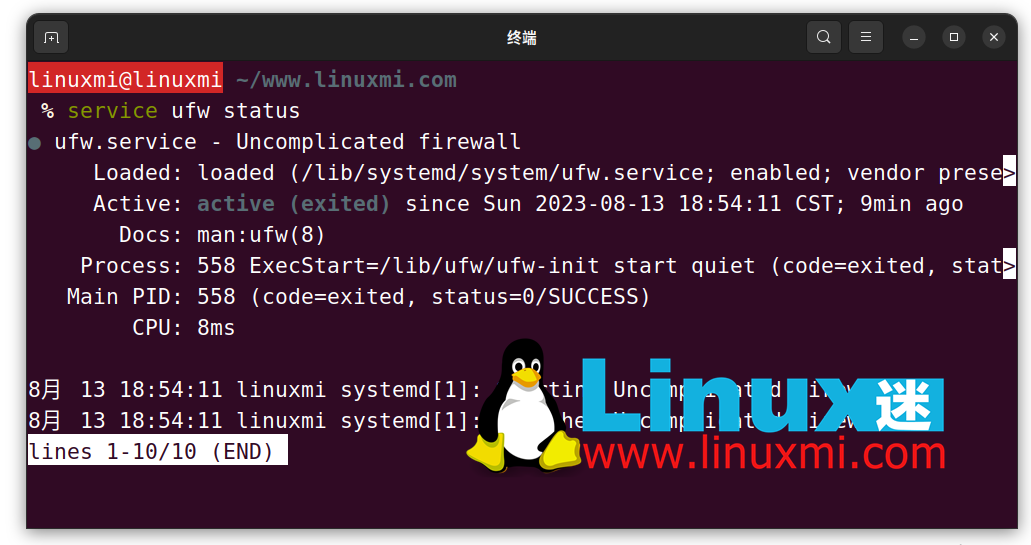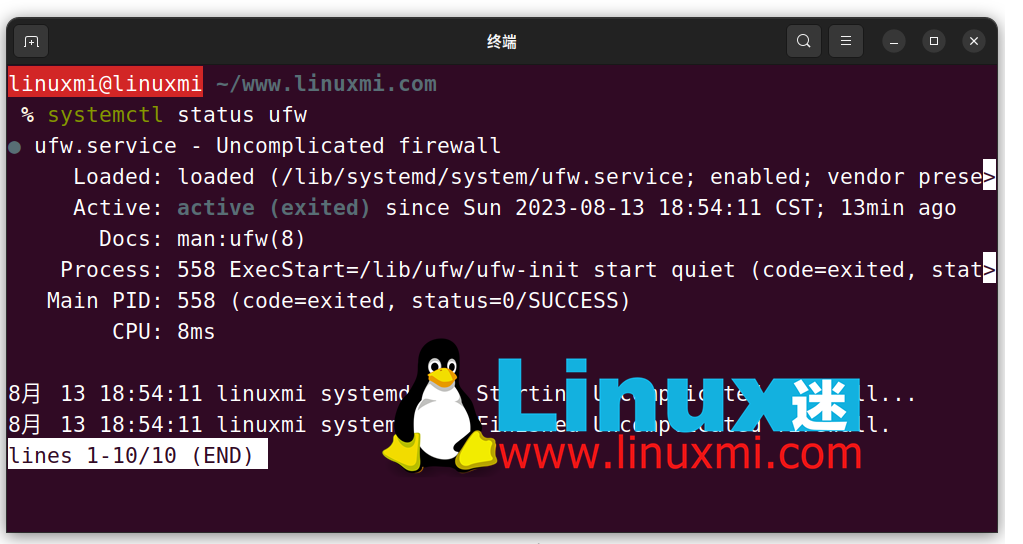What is the difference between service and systemctl in Linux?
In Linux, service and systemctl are two crucial and very similar commands. Their similarity can easily lead to wondering how they differ and whether they can be used interchangeably.
Understanding the details of service and systemctl will enable you to use them flexibly.
What is the function of service command in Linux?

Use the service command to check the firewall status
In Linux, the service command is a wrapper script that allows users to easily configure and interact with system services. It precedes systemd and works primarily with scripts located in /etc/init.d.
Although systemctl has largely replaced service's previous importance, it remains relevant through many legacy features.
The transition of the related init system from SysVinit to systemd was controversial, but increasing challenges with the functionality of the original init system made this transition necessary.
systemd starts services in parallel, rather than serially, giving it faster startup times than SysVinit and providing slightly more sophisticated control of system daemons via the command line interface (CLI).
What is systemctl command in Linux?

Use systemctl in the terminal to check the firewall status
Similar to service, systemctl is a very versatile command that allows you to enable, reload, start, stop, and check the status of services running on a Linux system.
systemctl acts as an easy-to-use and powerful interface for configuring files in systemd. For example, using systemctl can disable a service on startup with just one or two commands.
systemctl is backward compatible with the initialization system SysVinit and is mainly used with service. systemctl is not a direct successor of service, but it is more versatile and flexible in terms of tools for managing system services.
You can complete tasks such as blocking or disabling services in one or two lines of commands.
The difference between service and systemctl
service and systemctl largely serve the same purpose. Many of the similarities between them are intentional to make it easier for users to transition from service to systemctl.
However, when starting to use the init system on Linux, there are some differences between the two that you should be aware of.
Different initialization systems
The most significant difference between service and systemctl is that they belong to different initialization systems. service belongs to SysVinit (System V Init), which is the classic Linux initialization process.
systemctl belongs to systemd and is the successor of SysVinit and the modern initialization process used on many Linux systems.
Since service and systemctl are part of different initialization processes, they operate initialization system files in different directories. service works with the initialization system files located in /etc/init.d, while systemctl works with the initialization system files located in /lib/systemd.
Typically, you will encounter the systemd init system in an out-of-the-box Linux installation, so you will want to be familiar with using systemctl to interact with it.
If you plan to use on a system working before or at the same time as systemd was released in 2010, it doesn't hurt to be familiar with using the service command.
compatibility
From a compatibility perspective, service is still a very useful command - as a wrapper command, it can be redirected to the service manager used on different systems. If you will be working with a variety of Linux systems, you should plan to learn and incorporate it into your arsenal of tools.
Underlying functions
Another key difference between systemctl and service is how they operate. service is a high-level command that redirects to the underlying service manager used on a specific system, meaning it is very versatile across systems. It may redirect to /etc/init.d, upstart, or even systemctl. Meanwhile, the systemctl command interacts directly with systemd.
ability
In terms of achievable tasks, it can be safely said that systemctl far exceeds service in functionality. In addition to basic functions such as starting, stopping, enabling, or disabling specific services, you can also use systemctl to set advanced configurations.
Because a service must be compatible with the underlying service manager it depends on, its functionality is more limited.
Efficiently configure system services on Linux
service and systemctl are both extremely important commands for managing system services. Whether you just want to get the most out of your Linux system or you plan to work on a corporate network, it's crucial to become familiar with both commands.
Fortunately, there are many excellent tutorials that can help you become a master of using systemctl and service in the terminal.
The above is the detailed content of What is the difference between service and systemctl in Linux?. For more information, please follow other related articles on the PHP Chinese website!

Hot AI Tools

Undresser.AI Undress
AI-powered app for creating realistic nude photos

AI Clothes Remover
Online AI tool for removing clothes from photos.

Undress AI Tool
Undress images for free

Clothoff.io
AI clothes remover

AI Hentai Generator
Generate AI Hentai for free.

Hot Article

Hot Tools

Notepad++7.3.1
Easy-to-use and free code editor

SublimeText3 Chinese version
Chinese version, very easy to use

Zend Studio 13.0.1
Powerful PHP integrated development environment

Dreamweaver CS6
Visual web development tools

SublimeText3 Mac version
God-level code editing software (SublimeText3)

Hot Topics
 1359
1359
 52
52
 deepseek web version entrance deepseek official website entrance
Feb 19, 2025 pm 04:54 PM
deepseek web version entrance deepseek official website entrance
Feb 19, 2025 pm 04:54 PM
DeepSeek is a powerful intelligent search and analysis tool that provides two access methods: web version and official website. The web version is convenient and efficient, and can be used without installation; the official website provides comprehensive product information, download resources and support services. Whether individuals or corporate users, they can easily obtain and analyze massive data through DeepSeek to improve work efficiency, assist decision-making and promote innovation.
 How to install deepseek
Feb 19, 2025 pm 05:48 PM
How to install deepseek
Feb 19, 2025 pm 05:48 PM
There are many ways to install DeepSeek, including: compile from source (for experienced developers) using precompiled packages (for Windows users) using Docker containers (for most convenient, no need to worry about compatibility) No matter which method you choose, Please read the official documents carefully and prepare them fully to avoid unnecessary trouble.
 How to solve the permissions problem encountered when viewing Python version in Linux terminal?
Apr 01, 2025 pm 05:09 PM
How to solve the permissions problem encountered when viewing Python version in Linux terminal?
Apr 01, 2025 pm 05:09 PM
Solution to permission issues when viewing Python version in Linux terminal When you try to view Python version in Linux terminal, enter python...
 BITGet official website installation (2025 beginner's guide)
Feb 21, 2025 pm 08:42 PM
BITGet official website installation (2025 beginner's guide)
Feb 21, 2025 pm 08:42 PM
BITGet is a cryptocurrency exchange that provides a variety of trading services including spot trading, contract trading and derivatives. Founded in 2018, the exchange is headquartered in Singapore and is committed to providing users with a safe and reliable trading platform. BITGet offers a variety of trading pairs, including BTC/USDT, ETH/USDT and XRP/USDT. Additionally, the exchange has a reputation for security and liquidity and offers a variety of features such as premium order types, leveraged trading and 24/7 customer support.
 Get the gate.io installation package for free
Feb 21, 2025 pm 08:21 PM
Get the gate.io installation package for free
Feb 21, 2025 pm 08:21 PM
Gate.io is a popular cryptocurrency exchange that users can use by downloading its installation package and installing it on their devices. The steps to obtain the installation package are as follows: Visit the official website of Gate.io, click "Download", select the corresponding operating system (Windows, Mac or Linux), and download the installation package to your computer. It is recommended to temporarily disable antivirus software or firewall during installation to ensure smooth installation. After completion, the user needs to create a Gate.io account to start using it.
 Ouyi okx installation package is directly included
Feb 21, 2025 pm 08:00 PM
Ouyi okx installation package is directly included
Feb 21, 2025 pm 08:00 PM
Ouyi OKX, the world's leading digital asset exchange, has now launched an official installation package to provide a safe and convenient trading experience. The OKX installation package of Ouyi does not need to be accessed through a browser. It can directly install independent applications on the device, creating a stable and efficient trading platform for users. The installation process is simple and easy to understand. Users only need to download the latest version of the installation package and follow the prompts to complete the installation step by step.
 How to automatically set permissions of unixsocket after system restart?
Mar 31, 2025 pm 11:54 PM
How to automatically set permissions of unixsocket after system restart?
Mar 31, 2025 pm 11:54 PM
How to automatically set the permissions of unixsocket after the system restarts. Every time the system restarts, we need to execute the following command to modify the permissions of unixsocket: sudo...
 Ouyi Exchange Download Official Portal
Feb 21, 2025 pm 07:51 PM
Ouyi Exchange Download Official Portal
Feb 21, 2025 pm 07:51 PM
Ouyi, also known as OKX, is a world-leading cryptocurrency trading platform. The article provides a download portal for Ouyi's official installation package, which facilitates users to install Ouyi client on different devices. This installation package supports Windows, Mac, Android and iOS systems. Users can choose the corresponding version to download according to their device type. After the installation is completed, users can register or log in to the Ouyi account, start trading cryptocurrencies and enjoy other services provided by the platform.




